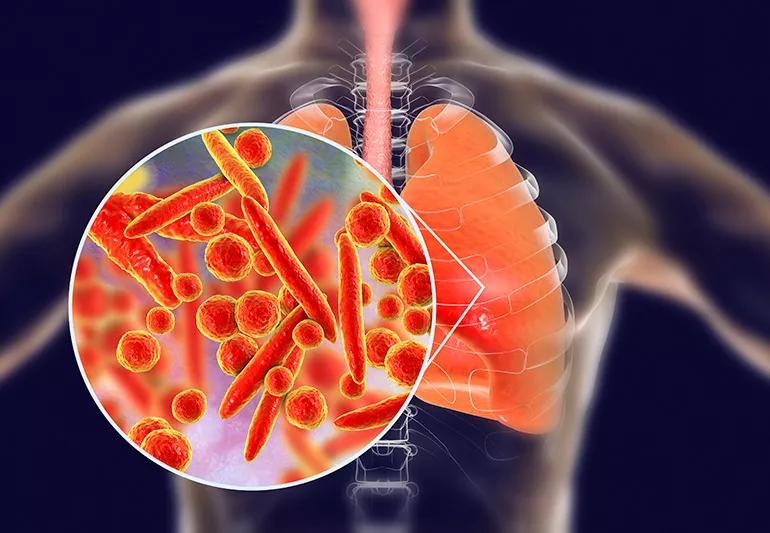When to seek medical attention + tips for avoiding it in the first place

When you have cold-like symptoms — headache, runny nose, cough and a sore throat — you likely slow down a bit, thinking you can beat it in a few days. But when the symptoms linger or worsen — not enough to knock you off your feet, but enough so that you can’t ignore them — you may have walking pneumonia.
Advertisement
Cleveland Clinic is a non-profit academic medical center. Advertising on our site helps support our mission. We do not endorse non-Cleveland Clinic products or services. Policy
Walking pneumonia (AKA atypical pneumonia) strikes about 2 million people in the United States each year. It tends to be less serious than traditional pneumonia, which hospitalizes about 1 million people and causes 50,000 deaths each year. In fact, you can be up and walking around, unaware that you have this type of pneumonia — that’s how it got its name.
But walking pneumonia can still leave you feeling lousy. And it’s highly contagious. Here, pulmonologist Neal Chaisson, MD, explains how you can end up with this common respiratory infection and how it differs from regular pneumonia.
Walking pneumonia is often caused by bacteria or viruses. Most commonly a bacteria called mycoplasma pneumoniae is responsible for the infection. The infection is often caused by inhaling airborne droplets of water that are contaminated with the bacteria or virus when an infected person coughs or sneezes. These bacteria and viruses then infect your nose, throat, windpipe and lungs.
That’s why children and younger adults develop it most often — the infection spreads easily in crowded environments like schools and college dormitories. But walking pneumonia can also hit nursing homes.
You’ll usually start feeling symptoms within two weeks of exposure, but the bacteria can incubate for up to a month — and you’re contagious during that incubation period. Over about four days, the symptoms gradually worsen and include:
Advertisement
Pneumonia is generally a more serious lung infection. It can also be caused by bacteria or viruses (or rarely, fungi).
No matter the cause, the infection causes your immune system to fill the air sacs in the lungs with mucus, pus, and other fluids. This makes it difficult for oxygen to reach your blood.
Though the symptoms of bacterial pneumonia and viral pneumonia aren’t exactly the same, Dr. Chaisson says both tend to cause shortness of breath, difficulty breathing and feeling more tired than usual.
For walking pneumonia, some doctors may evaluate your symptoms, assume that’s what you have and prescribe an antibiotic. But Dr. Chaisson doesn’t recommend that approach. “The vast majority of patients with these symptoms have something viral, such as an upper respiratory infection, sinus infection or bronchitis,” he explains. Such illnesses are treated with time, rest and symptom-relieving medication.
Dr. Chaisson cautions that antibiotic overuse can lead to antibiotic resistance and an outbreak of Clostridium difficile. C. difficile, an intestinal infection that causes diarrhea and abdominal pain, is difficult to treat and can lead to death — particularly in elderly patients.
That said, if your symptoms linger for longer than a few days or if you have a chronic health issue (like emphysema, asthma, diabetes, kidney disease or heart disease), it’s best to visit your doctor to see if you might have walking pneumonia.
Although walking pneumonia may go away on its own, antibiotics may be necessary. Walking pneumonia can be confirmed by a chest X-ray, which will show an area of infection in the lung.
Regular pneumonia, on the other hand, is often more severe, Dr. Chaisson says. “Regular pneumonia usually warrants antibiotics and sometimes patients are hospitalized because they require oxygen, IV fluids, and breathing treatments,” he says.
“No matter what type of pneumonia you have ― whether walking pneumonia or a more serious form ― it’s important not to try to rush your recovery,” Dr. Chaisson says. “Don’t push yourself too hard. Expect that it can take up to a few weeks until you’re up and running at full speed again.”
Advertisement
Learn more about our editorial process.
Advertisement

For centuries, people have been drinking mullein tea for respiratory conditions

Understand the symptoms and causes of these respiratory infections

The short answer from an infectious disease specialist

Here's when to see a doctor about that persistent cough

When symptoms call for a trip to the doctor

Most recommended precautions center around minimizing bruising or swelling

Even one drink can have an impact on your cognitive function leading to slurred speech, blurred vision and impaired memory

Type 2 diabetes isn’t inevitable with these dietary changes

Applying a hot or cold compress can help with pain